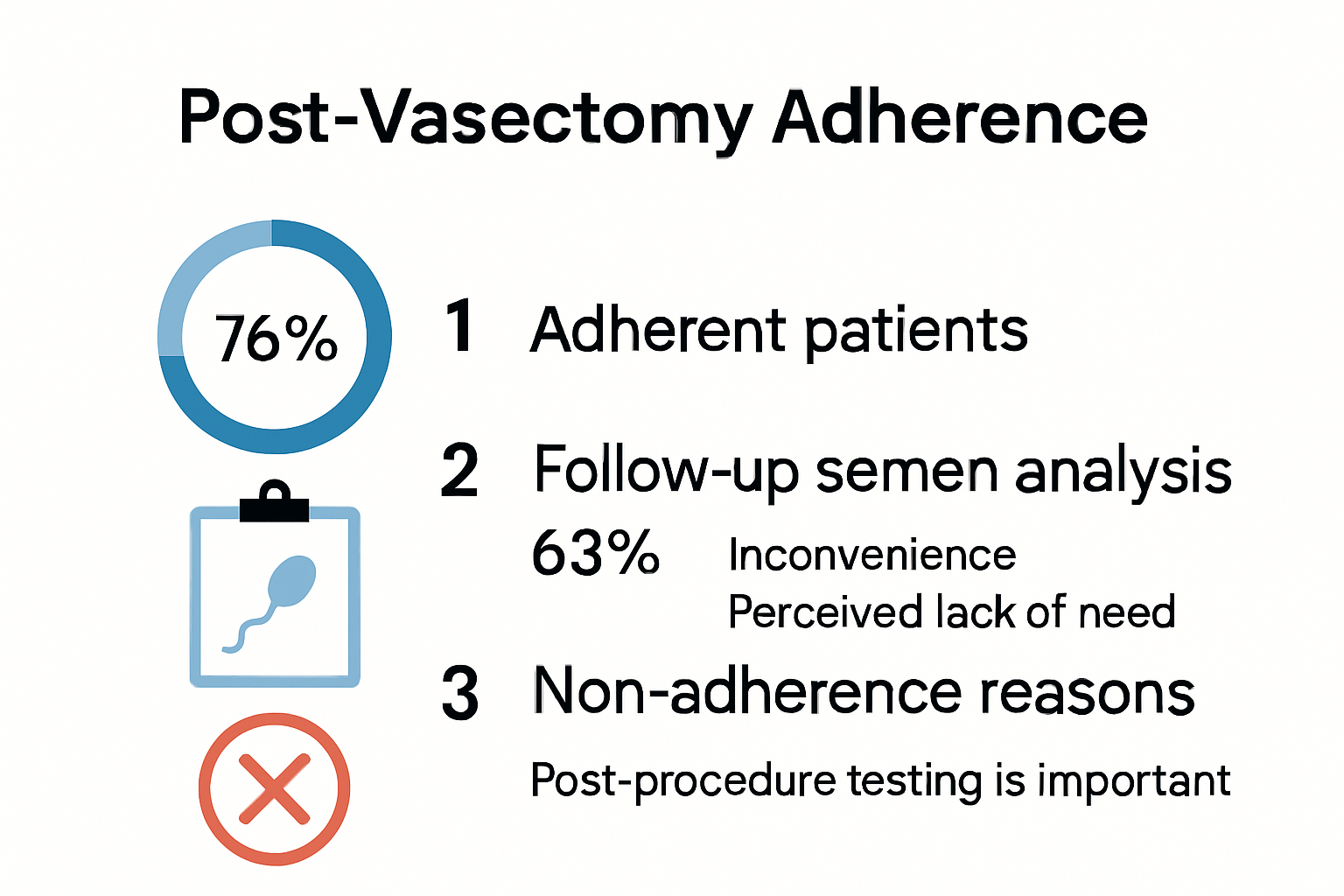Most men assume a vasectomy means their birth control worries are over. Yet here’s the surprise. A shocking study found that only 25 percent of men actually complete the crucial follow-up semen test, leaving many at risk for accidental pregnancies. Instead of the medical procedure itself, it’s the maze of missed appointments, financial hurdles, and forgotten tests that truly threatens success after a vasectomy.
Table of Contents
- Understanding Patient Adherence Post Vasectomy
- Common Barriers And How To Overcome Them
- Best Practices For Vasectomy Confirmation And Follow-Up
- Supporting Partners And Clinics For Better Outcomes
Quick Summary
| Takeaway | Explanation |
|---|---|
| Patient adherence is crucial for vasectomy success | Completing post-procedure steps, particularly semen analysis, is essential for confirming effectiveness and minimizing reproductive risks. |
| Address financial challenges to improve compliance | Financial burdens can hinder adherence; solutions include advocating for insurance coverage expansion and offering flexible payment plans. |
| Implement personalized follow-up strategies | Smaller urology practices have achieved higher compliance rates, indicating that personalized, patient-centered approaches enhance follow-up participation. |
| Engage partners for better outcomes | Partner involvement significantly impacts adherence, making open communication and shared decision-making critical for successful follow-up. |
| Education is key to overcoming psychological barriers | Providing clear, comprehensive information about the importance of post-vasectomy testing can alleviate anxiety and promote adherence. |
Understanding Patient Adherence Post Vasectomy
Patient adherence following a vasectomy represents a critical aspect of reproductive health management that directly impacts the procedure’s ultimate success. While vasectomy is a highly effective form of permanent contraception, its effectiveness hinges on patients completing essential post-procedure steps, particularly semen analysis testing.

The Reality of Patient Follow-Up Challenges
Recent research reveals significant gaps in patient compliance that demand immediate attention. Research from the American Urological Association uncovered a stark reality: only 69% of patients completed postvasectomy semen analysis (PVSA) at 16 weeks, with compliance increasing to 82% by 40 weeks. This data underscores the persistent challenges men face in fully adhering to post-vasectomy medical recommendations.
Moreover, a disturbing trend emerges from recent studies. Comprehensive medical research found that merely 25% of participants underwent PVSA, despite prior reports suggesting compliance rates up to 78%. This significant discrepancy highlights a critical gap between recommended medical protocols and actual patient behavior.
Factors Influencing Patient Non-Adherence
Multiple interconnected factors contribute to patient non-adherence post vasectomy. Psychological barriers play a substantial role, with many men experiencing anxiety about follow-up testing or harboring misconceptions about the procedure’s effectiveness. Clinical research indicated that 42.1% of men did not follow up at all after their vasectomy, suggesting deep-rooted hesitation.
Key barriers to patient adherence include:
- Psychological Resistance: Fear of potential complications or confirmation of procedure failure
- Logistical Challenges: Difficulty scheduling follow-up appointments
- Limited Understanding: Insufficient knowledge about the importance of post-vasectomy testing
Addressing these challenges requires a multifaceted approach that combines patient education, convenient testing options, and clear communication. Learn more about navigating post-vasectomy testing challenges to understand how modern solutions are transforming patient experiences.
Successful patient adherence demands proactive strategies that prioritize patient comfort, accessibility, and comprehensive understanding. By recognizing the psychological and practical barriers men face, healthcare providers can develop more effective approaches to ensure thorough post-vasectomy follow-up and ultimately improve reproductive health outcomes.
Common Barriers and How to Overcome Them
Navigating the post-vasectomy journey involves addressing multiple complex barriers that can significantly impact patient adherence and overall reproductive health outcomes. Understanding these challenges is crucial for developing effective strategies that support men throughout their post-procedure recovery and testing process.
Financial and Accessibility Challenges
One of the most significant obstacles to patient adherence is the financial burden associated with vasectomy and follow-up care. Research from the American Urological Association reveals that out-of-pocket costs for vasectomy procedures can range dramatically from $300 to $3,500. These substantial expenses create a substantial barrier not only to the initial procedure but also to recommended follow-up testing.
Healthcare providers and policymakers must recognize that financial constraints can prevent men from completing critical post-vasectomy steps. Potential solutions include:
- Insurance Coverage Expansion: Advocating for more comprehensive insurance plans that cover vasectomy and follow-up testing
- Sliding Scale Options: Developing cost-effective testing alternatives
- Payment Plans: Creating flexible financial arrangements for patients
Timing and Procedural Barriers

Optimal timing of postvasectomy semen analysis (PVSA) plays a crucial role in patient adherence and successful outcomes. Medical research suggests that scheduling the initial analysis between 6 to 18 weeks post-vasectomy can significantly improve patient compliance and ensure adequate sperm clearance.
Interestingly, clinical studies demonstrate that smaller urology practices achieve approximately 60% higher compliance rates compared to larger medical facilities. This finding suggests that personalized, patient-centered approaches can dramatically enhance follow-up participation.
Psychological and Educational Interventions
Psychological barriers remain a critical factor in patient non-adherence. Many men experience anxiety about follow-up testing, fear potential complications, or lack comprehensive understanding of the procedure’s importance. Addressing these concerns requires a multifaceted educational approach that combines:
- Clear Communication: Providing detailed, easy-to-understand information about the vasectomy process
- Emotional Support: Offering resources that address potential psychological concerns
- Comprehensive Patient Education: Developing targeted materials that explain the importance of follow-up testing
Explore our comprehensive guide on post-vasectomy testing challenges to gain deeper insights into overcoming these barriers.
Successful patient adherence requires a holistic approach that recognizes the interconnected financial, procedural, and psychological challenges men face. By implementing patient-centered strategies that address these barriers comprehensively, healthcare providers can significantly improve post-vasectomy care outcomes and support men through this important reproductive health journey.
Best Practices for Vasectomy Confirmation and Follow-Up
Vasectomy confirmation represents a critical step in ensuring reproductive health and contraceptive effectiveness. Implementing comprehensive and precise follow-up protocols is essential for patients seeking definitive confirmation of their procedure’s success.
Official Guideline Recommendations
The American Urological Association provides clear guidelines emphasizing the critical importance of post-vasectomy semen analysis (PVSA) to confirm sterility and minimize potential reproductive risks. These recommendations form the cornerstone of best practices in vasectomy follow-up.
Key official recommendations include:
- Timing of Testing: Conduct semen analysis after a minimum of three months post-procedure
- Ejaculation Requirement: Perform testing after approximately 20 ejaculations
- Sample Verification: Confirm complete absence of sperm in the ejaculate
Semen Analysis Protocol
Clinical guidelines from multiple healthcare institutions consistently recommend a standardized approach to post-vasectomy testing. The primary objective is to demonstrate azoospermia (absence of sperm) in the semen sample.
The recommended protocol involves:
- Collecting a semen sample at least 12 weeks after the vasectomy
- Ensuring at least 20 ejaculations have occurred since the procedure
- Submitting the sample for comprehensive laboratory analysis
Learn more about confirming your vasectomy success to understand the nuanced steps involved in this critical process.
Interpreting Test Results
Research from the American Academy of Family Physicians indicates that a single post-vasectomy semen analysis demonstrating azoospermia is generally sufficient to establish sterility. However, understanding result interpretation is crucial for patients.
Comprehensive result interpretation involves:
- Negative Result: Complete absence of sperm, indicating successful vasectomy
- Borderline Result: Presence of limited sperm, requiring additional testing
- Positive Result: Active sperm present, necessitating further medical consultation
Patients should work closely with healthcare providers to understand their specific test results and potential next steps. Thorough follow-up and clear communication remain paramount in ensuring successful vasectomy outcomes and patient confidence in their reproductive health management.
Supporting Partners and Clinics for Better Outcomes
Successful vasectomy outcomes extend beyond the medical procedure itself, requiring comprehensive support from partners, clinics, and healthcare providers. Understanding the intricate dynamics of emotional, medical, and collaborative support can significantly enhance patient experiences and long-term reproductive health management.
Partner Involvement and Emotional Support
Research indicates that partner involvement plays a crucial role in post-vasectomy adherence. In a comprehensive cohort study, 94% of patients who returned for post-vasectomy semen analysis (PVSA) were married, highlighting the significant impact of partner support on medical follow-through.
Key strategies for partner support include:
- Open Communication: Encouraging honest discussions about expectations and potential concerns
- Shared Decision Making: Involving partners in post-procedure planning and follow-up
- Emotional Validation: Recognizing and addressing potential psychological challenges
Clinic Support and Patient Compliance
Clinical studies reveal important insights into patient compliance. Smaller urology practices demonstrated higher PVSA compliance rates, suggesting that personalized, patient-centered approaches can dramatically improve follow-up participation. Patient compliance increased from 69% at 16 weeks to 82% by 40 weeks when clinics implemented supportive strategies.
Effective clinic support mechanisms include:
- Personalized Follow-up: Implementing individualized communication protocols
- Educational Resources: Providing comprehensive post-procedure guidance
- Accessible Support Channels: Creating multiple touchpoints for patient communication
Comprehensive Care Model
Vasectomy success resources emphasize the importance of holistic support. Emotional challenges can significantly impact patient experiences, particularly in cases of unexpected outcomes or testing complexities.
A comprehensive care model should address:
- Psychological Support: Offering counseling and emotional resources
- Collaborative Approach: Integrating partner perspectives in medical decision-making
- Continuous Education: Providing ongoing information and support throughout the post-vasectomy journey
Successful vasectomy outcomes require a nuanced, supportive approach that recognizes the interconnected needs of patients, partners, and healthcare providers. By fostering open communication, providing personalized support, and creating comprehensive care strategies, clinics can significantly improve patient experiences and long-term reproductive health management.
Frequently Asked Questions
What is the importance of post-vasectomy follow-up?
Completing a post-vasectomy follow-up, especially a semen analysis, is crucial to confirm sterility and minimize the risk of unintended pregnancies.
Why do so few men complete their semen tests after a vasectomy?
Barriers such as financial concerns, scheduling difficulties, and psychological resistance contribute to low completion rates for semen analyses after a vasectomy.
How can financial challenges impact post-vasectomy adherence?
Financial burdens can deter patients from undergoing necessary follow-up testing, making it vital to advocate for better insurance coverage and flexible payment options to enhance compliance.
What role do partners play in post-vasectomy adherence?
Partner involvement is significant, as emotional support and shared decision-making can encourage men to complete necessary follow-up tests and enhance overall adherence.
Recommended Articles
- Vasectomy Patient Education: What Every Man Needs to Know
- Top Challenges in Post Vasectomy Testing: 2025 Guide for Patients and
- Vasectomy Success Rate in 2025: What Men and Couples Need to Know
- Vasectomy Procedure Explanation: What to Expect in 2025
- Post Vasectomy Sperm Clearance: What to Know in 2025
- Your Post Vasectomy Timeline: Recovery, Testing, and Next Steps





